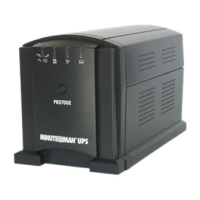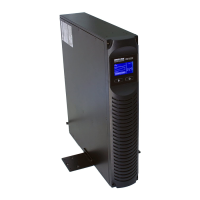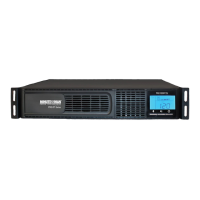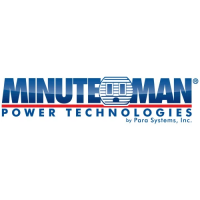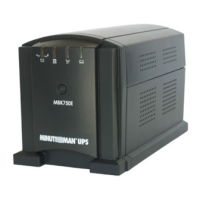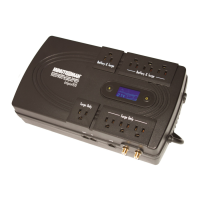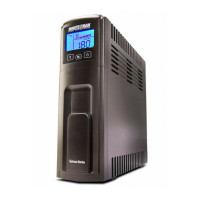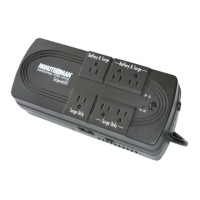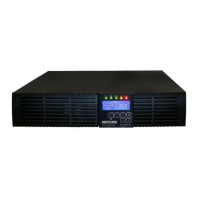Do you have a question about the Minuteman PRO-E and is the answer not in the manual?
Key safety instructions to save and follow before installation and use.
Warning about AC leakage current and its potential risk of electrical shock.
Guidelines for connecting the UPS to a grounded AC wall outlet to prevent hazards.
Advice to disconnect UPS from AC outlet before installing interface cables if grounding is unverified.
Alert that UPS power supply parts are energized by battery even with AC input disconnected.
Explanation of the On-Line/On-Battery/Boost/Buck, Fault, Overload, and Weak/Bad Battery LEDs.
Identification and description of rear panel connectors and features for 120V models.
Identification and description of rear panel connectors and features for 230V models.
Instructions on connecting equipment to UPS output receptacles and avoiding extensions.
Warning against connecting laser printers to UPS unless rated 2000VA or greater.
Warning against plugging power strips or surge protectors into "Battery Backup" receptacles.
Recommendation to use a Qualified Electrician if a Site Wiring Fault (SWF) is indicated.
Prohibition of connecting Fax/Modem/Phone lines to RJ45 sockets on 230V models.
Procedure for turning the UPS unit ON and OFF using the ON/OFF/Test Button.
Explanation of the UPS self-test feature, its purpose, and automatic testing.
How to change DIP switch settings to configure inverter output voltage and related settings.
Describes the two beeps every five seconds alarm indicating low battery reserve.
Explanation of the Weak/Bad Battery LED and alarm indicating battery issues.
Description of the constant alarm and illuminated Overload LED when load exceeds UPS rating.
Description of the constant alarm and illuminated Fault LED for hardware faults.
Troubleshooting steps for when the UPS will not turn on, focusing on the button.
Troubleshooting for UPS operating only on battery, checking AC circuit breaker.
Steps to address insufficient runtime, involving battery charging and potential replacement.
Troubleshooting for Weak/Bad Battery LED, checking connections and charging.
Warning that battery replacement is for authorized service personnel only due to hazardous voltages.
Strong warning about hazardous voltages within the UPS during battery replacement.
Precautions to prevent electrical shock from battery system voltages and high current.
List of safety steps like removing metal objects, using insulated tools, and wearing protective gear.
Initial steps to take when the UPS requires service, including troubleshooting and contacting support.
Key safety instructions to save and follow before installation and use.
Warning about AC leakage current and its potential risk of electrical shock.
Guidelines for connecting the UPS to a grounded AC wall outlet to prevent hazards.
Advice to disconnect UPS from AC outlet before installing interface cables if grounding is unverified.
Alert that UPS power supply parts are energized by battery even with AC input disconnected.
Explanation of the On-Line/On-Battery/Boost/Buck, Fault, Overload, and Weak/Bad Battery LEDs.
Identification and description of rear panel connectors and features for 120V models.
Identification and description of rear panel connectors and features for 230V models.
Instructions on connecting equipment to UPS output receptacles and avoiding extensions.
Warning against connecting laser printers to UPS unless rated 2000VA or greater.
Warning against plugging power strips or surge protectors into "Battery Backup" receptacles.
Recommendation to use a Qualified Electrician if a Site Wiring Fault (SWF) is indicated.
Prohibition of connecting Fax/Modem/Phone lines to RJ45 sockets on 230V models.
Procedure for turning the UPS unit ON and OFF using the ON/OFF/Test Button.
Explanation of the UPS self-test feature, its purpose, and automatic testing.
How to change DIP switch settings to configure inverter output voltage and related settings.
Describes the two beeps every five seconds alarm indicating low battery reserve.
Explanation of the Weak/Bad Battery LED and alarm indicating battery issues.
Description of the constant alarm and illuminated Overload LED when load exceeds UPS rating.
Description of the constant alarm and illuminated Fault LED for hardware faults.
Troubleshooting steps for when the UPS will not turn on, focusing on the button.
Troubleshooting for UPS operating only on battery, checking AC circuit breaker.
Steps to address insufficient runtime, involving battery charging and potential replacement.
Troubleshooting for Weak/Bad Battery LED, checking connections and charging.
Warning that battery replacement is for authorized service personnel only due to hazardous voltages.
Strong warning about hazardous voltages within the UPS during battery replacement.
Precautions to prevent electrical shock from battery system voltages and high current.
List of safety steps like removing metal objects, using insulated tools, and wearing protective gear.
Initial steps to take when the UPS requires service, including troubleshooting and contacting support.
| Category | UPS |
|---|---|
| Input Voltage | 120V |
| Output Voltage | 120V |
| Topology | Line Interactive |
| Communication Ports | USB |
| Humidity | 0-95% non-condensing |
| Form Factor | Tower |
| Number of Outlets | 8 |
| Input Frequency | 50/60Hz |
| Output Frequency | 50/60Hz |
| Transfer Time | 4 ms typical |
| Battery Type | Sealed Lead Acid |
| Typical Recharge Time | 8 hours |
| Operating Temperature | 0°C to 40°C |
| Storage Temperature | -15°C to 50°C |
| Outlets | 6 x NEMA 5-15R |
| Weight | 24.3 lbs |
